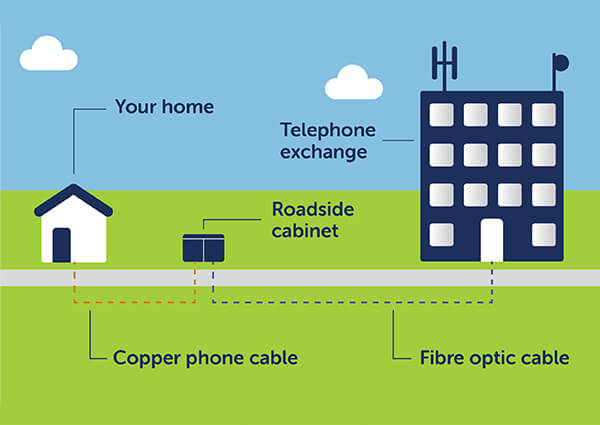Fibre broadband is a type of high-speed broadband, it uses fibre optic cables instead of normal copper wire. These fibre optic cables are much better at transferring data. When we say data, we mean download speed/upload speed, this might make streaming movies, playing online games and browsing the internet faster. Is it worth upgrading to a fibre optic breadboard? Let’s find out.
How much faster is fibre than copper?
When you are looking at upgrading your broadband, it’s important to look at whether you will get copper or fibre wire broadband to connect you to the internet. There are a number of factors to also consider, such as your networking needs, how much bandwidth you have, distance to your broadband box, environment, cost, and more.
Fibre optic cables beat copper in this department, and it isn’t even close. Fibre optic cables are made of tiny strands of glass, each about the size of a human hair, and use light pulses. Thus, they can carry a lot of data—up to 60 terabits per second—at speeds just slightly slower than the speed of light. Copper cables, limited by the speed at which electrons travel, can only reach about 10 gigabits per second.
Fibre optic cable is becoming one of the fastest-growing transmission mediums. Fibre optics is normally favoured when you want a faster connection and higher bandwidth. It’s ideal for high data-rate systems such as Gigabit Ethernet, FDDI, multimedia, ATM, SONET, Fibre Channel, or any other network that requires the transfer of large, bandwidth-consuming data files, particularly over long distances.
Advantages of Fibre Optic
Better bandwidth: Fibre provides far greater bandwidth than copper and has proven performance at rates up to 10 Gbps. Fibre optic cables carry a much greater amount of data.
Very little signal lost: Fibre optic signal is made of light, so there is very little signal lost. Since copper is a physical wire, there is friction, but the light has zero friction. Data can move at higher speeds and greater distances. Fibre does not have the 100-meter (304.8-ft.) distance limitation of unshielded twisted-pair copper (without a booster). Fibre distances can range from 300 meters to 40 kilometres, depending on the style of cable, wavelength, and network. (Fibre distances are typically measured in metric units.) Because fibre signals need less boosting than copper ones do, the cable performs better. – Read more from the source of this info here.
Fibre is safer: It’s very difficult to tap into the data that is being transferred over a fibre optic cable. If the cable is tapped, its easy to pick up as there is light leakage, causing the entire system to fail.
Reliability: Fibre has a very reliable transmission, it’s immune to any environmental factors that would affect copper wires. Fibre cables are made of glass which does not conduct an electric current. It’s immune to any interference, cross talk etc. You can run fibre optic cables alongside any industrial equipment without any issues.
Design: Fibre is lightweight, thin, and more durable than copper cable. And, contrary to what you might think, fibre optic cable has pulling specifications that are up to ten times greater than copper cables. Its small size makes it easier to handle, and it takes up much less space in cabling ducts.
Price: Although the cost of fibre optics is higher than copper wire, it’s steadily getting cheaper and cheaper. Fibre is more expensive than copper in the short run, but it may actually be less expensive in the long run. Fibre typically costs less to maintain, has much less downtime, and requires less networking hardware. And fibre eliminates the need to recable for higher network performance.
Here’s a quick table to compare fibre and copper:
| Parameter | Fiber Optics | Copper |
| Bandwidth | 60 Tbps and beyond | 10 Gbps |
| Future-Proof | Evolving towards the desktop | CAT7 in development |
| Distance | 12 Miles+ @ 10,000Mbps | 300 Ft. @ 1,000Mbps |
| Noise | Immune | Susceptible to EM/RFI interference, crosstalk and voltage surges |
| Security | Nearly impossible to tap | Susceptible to tapping |
| Handling | Lightweight, thin diameter, strong pulling strength | Heavy, thicker diameter, strict pulling specifications |
| Lifecycle | 30-50 Years | 5 Years |
| Weight/1,000 ft. | 4 Lbs. | 39 Lbs. |
| Energy Consumed | 2W per User | >10W per User |
Table found on – https://www.multicominc.com/training/technical-resources/copper-vs-fiber-which-to-choose/
Do I get Fibre directly to my house?
Sometimes the fibre optic cable goes from the telephone exchange to the roadside cabinet. Then from the cabinet to your home, it’s normally copper wire, this is called FTTC broadband or Fibre To The Cabinet. FTTP stands for Fibre To The Premises, this is ultrafast broadband or Full Fibre broadband. With FTTP, fibre optic cables run right into your home. This means much faster fibre broadband. But FTTP is not currently available everywhere in the UK.


How fast is fibre broadband?
Ultrafast FTTP is normally around 300Mbps, this is according to Ofcom. But most fibre connections in the UK are superfast FTTC, and they offer download speeds of at least 30Mbps. The speed you get will depend on how far away you are from the cabinet.
Want to learn more about the services we offer, get in touch with us or visit any of our other websites:
Visit our homepage here
